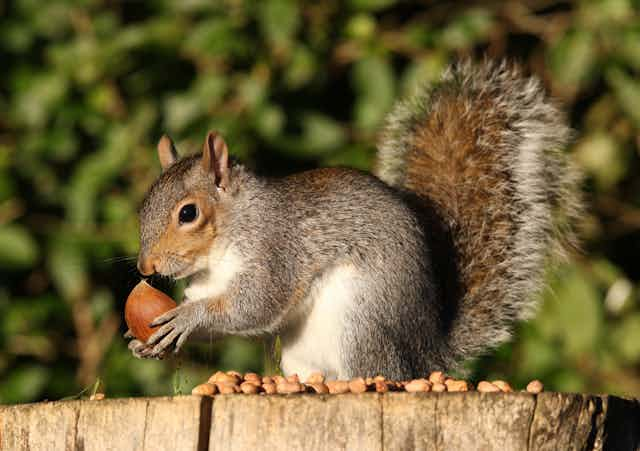There are thought to be 2.7 million grey squirrels in the UK, versus only 287,000 red squirrels. The invasive greys, brought to Britain and Ireland from North America in the 1870s, are blamed for the disappearance of the native red throughout much of England and Wales, due to the squirrel pox virus they transmit and the fact that they compete for food and habitat with their smaller relatives.
As with the UK’s other invasive species, such as rabbits, signal crayfish and Japanese knotweed, introducing the grey squirrel has proved to be an expensive mistake. Not only do grey squirrels displace red squirrels, they strip bark from trees. A recent report estimated that this could cost commercial forestry and native woodlands £1.1 billion (US$1.5 billion) over the next 40 years, including revenue lost to damaged timber, reduced carbon storage, tree replacement costs and squirrel control.
Despite efforts to kill grey squirrels over several decades, their populations remain large and widespread. So could government-backed plans for using oral contraceptives to control their breeding be the turning point?

Squirrel birth control
Before we consider that question, let’s interrogate the idea that grey squirrels are bad for the environment because they damage trees. If we’re worried about carbon in the atmosphere then phasing out fossil fuels, not killing squirrels, is the top priority. And squirrels, even non-native greys, play an important role in woodlands by burying the nuts they find and seeding new trees. If grey squirrels were to vanish overnight, then the natural regeneration of UK woodlands would probably slow.
Whether or not the damage caused by this invasive species is exaggerated, these reports inevitably encourage calls for bigger culls of grey squirrels. Oral contraceptives might at least be a more humane alternative to live trapping and bludgeoning the animals to death.
Birth control has worked for keeping wildlife populations elsewhere in check. The method, which often involves injecting contraceptives, has proved successful in more than 85 species, including wild horses and elephants, according to a 2011 review. Contraceptives halved dense and destructive populations of North American white-tailed deer in under 10 years.
Research into using oral contraceptives on grey squirrels in the UK has been ongoing for several years, and recent results show promise. Trials using feeders that only grey squirrels can access, baited with hazelnut spread laced with an immunocontraceptive (a drug which tricks the body’s immune system into producing antibodies that interfere with reproduction, by blocking the sperm receptor sites on eggs, for example) indicate that around 90% of a local population can be treated using this method. Researchers hope this could induce infertility to such an extent that treated populations shrink substantially over time.
Contraceptives have their own ethical concerns though. Being alive isn’t necessarily always better than being dead. We don’t really know what physiological and psychological effects an inability to breed will have on the welfare of grey squirrels.
It’s also important that this contraceptive doesn’t affect other species, though there are measures to ensure this. Bespoke feeding boxes that only grey squirrels can enter limit the risk to other species, in particular red squirrels, by weighting the door of the feeder so that the smaller red cannot enter. Providing the bait in a hazelnut spread, rather than nuts which squirrels may bury, prevents other animals inadvertently finding and eating the contraceptive. But what about predators? Will their fertility be threatened by eating prey dosed with contraceptives?
The alternatives
There are other ways to control grey squirrel populations, such as gene drives. These are altered genes that can be implanted in males and programmed to induce infertility in the genome of their female offspring. Female infertility spreads through the population as the gene drive is carried and inherited by males. Gene drives don’t carry the same risk of cross-contamination between species that contraceptives do, and they are cheaper and easier to implement.
But they still have a long way to go before they’re approved as a control method, as scientists worry that a gene drive could spread from invasive to native populations. Imagine a grey squirrel in the UK that had been treated with a gene drive somehow made it back into their native range in North America – it could mean their extinction.
Perhaps the most popular solution to the grey problem is the pine marten, a predatory mammal that is slightly larger than a ferret. Almost hunted to extinction in the UK, pine martens have made a comeback in recent years. Research suggests that where martens return to woodland they reduce grey squirrel populations, while boosting the number of red squirrels. But pine martens aren’t going to colonise the entire country – and they are still predators which eat other wildlife and some domestic animals. Their return is likely to face resistance in some places.

A recent study suggested the most efficient way to control grey squirrels is a combination of culling and contraceptives. So no matter how effective an oral contraceptive is, culls are likely to continue. Animal welfare campaigners are lobbying the government to at least halt culls during the breeding season, when female grey squirrels have kits in the nest. As it stands, mothers can be killed and their offspring left to starve.
I’ve written in defence of grey squirrels before, but I support controlling their populations with contraceptives. While I’d prefer nature to provide its own solution, I welcome methods of controlling so-called pest species that minimise pain and stress. Just because a species causes damage doesn’t mean that we can’t manage them with consideration for ethics and welfare.

